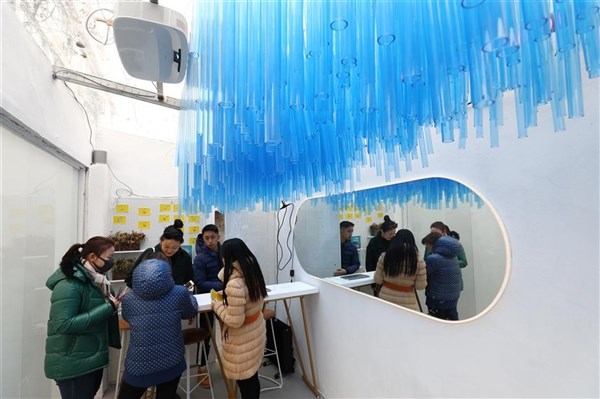今日上海
愚园路水饺店变身公共艺术空间 - 2019年02月22日
Small dumpling shop becomes new space for innovative, interactive art

A tiny street art gallery renovated from a dumpling shop on Yuyuan Road has become a popular site featuring creative art installations and high-tech gadgets.
The non-profit gallery titled The Bun, better known as 9m2 or nine square meters, is attracting curious spectators every day and night with its ideal location on the sidewalk along the century-old road in Changning District.
Three young artists renovated the space and change the theme every three months. A new exhibition was released this week, themed on nature and the ocean. It features hundreds of hanging acrylic blue tubes and a 4K projector that can turn the glass house into an underwater world in the evening.
“We want to create pleasant experiences for visitors and nearby residents, while raising public awareness of nature and society,” said Wang Zhiguang, co-founder of The Bun art project. Wang and his partners, formerly organizers of mass art exhibitions and concerts, took over the derelict house in August 2018 and started the renovation.
Though it looks like an illegal structure, the small house on a sidewalk near the entrance of an old residential community has been legally registered, dating back to over half a century ago, Wang said. Creater, the firm in charge of an ongoing revamping project on the road, rented the site and invited Wang’s team to host art exhibitions.
The former dumpling shop has been moved into a newly developed Yuyuan Public Market nearby, where residents can buy traditional Shanghai breakfast foods, get new keys cut or fix a broken umbrella. The market will officially open on February 28.
Redecoration lasted for two months. The artists removed the former rooftop and walls, which have been occupied by mice, and replaced them with glass.
“I’ve been watching their renovation project and curious about what the small house will be used for,” said Ma Zhongren, a senior resident living in the nearby Hongye Garden. “It turned out to be a beautiful space and I bring my grandson here every day,” Ma said.
The inaugural exhibition in October 2018 was decked out with colorful neon-stripes that turned the house into a glowing box every evening. The project themed on “Glowing Out Loud” invited visitors to play with reflector plates installed on the wall to change the pattern of the light.
“We found it meaningful to bring modern art to the residents in old neighborhoods who may have few chances to see art exhibitions at museums,” said Wang. He preferred to sit inside the house when it is open to the public between 3pm and 7pm every Wednesday to Sunday and talk with residents and other visiting artists.
The second exhibition also become a hot event, even among local expats, Wang said. During the city’s fallen leaves season, the artists decorated the house with flowers, tree trucks and other plants under the theme of nature. The glass rooftop of the house was later covered with fallen leaves and integrated with the surrounding environment. Over 100 visitors entered the small room every day on weekends.
“Their light and affordable materials create magic space here. People are so welcome to come in and interact with the art installation,” said Paul Leavy, a tourist from Toronto.
The artists have a bigger vision for their future exhibitions. They aim to involve more high-tech facilities to create more attractive art effects. Artificial intelligence sensors, 5G network and binocular cameras have been taken into consideration.
In one of the visions, for instance, the lamps in the house can change color automatically according to the clothes of entering visitors, while a 3D virtual receptionist can talk with them.
The art group is negotiating with the Chinese Academy of Sciences to showcase more newly invented technologies inside the exhibition space. The practice can help realize the visions of artists, while soliciting public opinions and seeking cooperation for new technologies.
“We want to turn exhibition spaces like 9m2 into a public lab where art and science can be well integrated,” said Huang Zhiwei, vice president the Shanghai Creater Industrial Co. Popular art installations within The Bun house will be copied in other projects of the company citywide.
The project is part of the ongoing campaign initiated by the Jiangsu Road Subdistrict and Creater to launch a number of micro-revamping projects in old residential communities along the road. There are 108 historical villas along the road, including many former residences of celebrities, such as missile and space scientist Qian Xuesen (1911-2009) and pianist Gu Shengying (1937-1967).
The road — which dates back to 1911, the final year of the Qing Dynasty (1644-1911) — runs through the districts of Changning and Jing’an. In recent decades it has been shortened to its current length of 800 meters.
